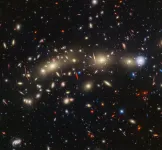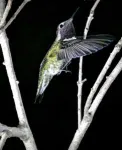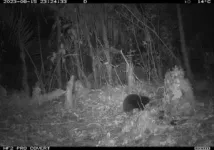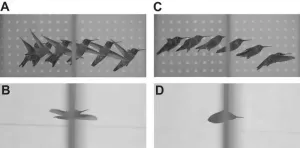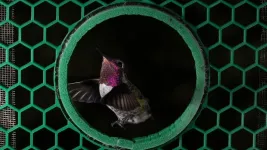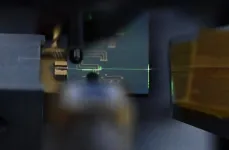(Press-News.org) Astronomers once again have combined the observational powers of NASA’s James Webb Space Telescope and Hubble Space Telescope to create one of the most detailed and colorful portraits of the cosmos, just in time for the holiday season.
The new image, dubbed the Christmas Tree Galaxy Cluster by the research team that includes Texas A&M University astronomer Dr. Lifan Wang, combines visible light from Hubble with infrared light detected by Webb to showcase MACS0416, a galaxy cluster about 4.3 billion light-years from Earth. Because the cluster is able to magnify the light from more distant background galaxies through a phenomenon known as gravitational lensing, it has enabled researchers to identify magnified supernovae and even very highly magnified individual stars.
“We’re calling MACS0416 the Christmas Tree Galaxy Cluster, both because it’s so colorful and because of these flickering lights we find within it,” said University of Missouri astronomer Dr. Haojing Yan, lead author of one of two papers describing the scientific results. The paper, co-authored by Wang, has been accepted for publication in The Astrophysical Journal.
Wang, a member of the Texas A&M Department of Physics and Astronomy and the George P. and Cynthia Woods Mitchell Institute for Fundamental Physics and Astronomy since 2006, is part of a time-domain astronomy team that is using JWST to discover the universe’s very first supernovae, the oldest of which on record dates back to a time when the universe was more than 3 billion years old. The international collaboration, known as the Prime Extragalactic Areas for Reionization and Lensing Science (PEARLS), is led by Arizona State University astronomer Dr. Rogier Windhorst and credited with acquiring the data resulting in the discoveries.
One of the team’s tactics is to use the unparalleled observing power of Webb to search for objects varying in observed brightness over time, known as transients. In a 2017 white paper published prior to the launch of JWST, Wang and his co-authors predicted that the telescope would find a few such transients in a single shot using its powerful main imager, called the Near Infrared Camera (NIRCam). Wang cites the MACS0416 image and the 14 transients it contains as proof positive, noting that the discoveries are exceeding the team’s predictions.
“The JWST is discovering a large number of transient objects, mostly supernovae, in the universe,” Wang said. “Not only it is finding supernovae, it has also found stars in faraway galaxies that are magnified by the gravitational field of nearby foreground galaxies.”
The discoveries are made through repeated observations of a sky area toward the galaxy cluster MACS0416. The Northern Ecliptic Pole (NEP), a region where JWST can continuously point to and take data throughout the year, is ideal for acquiring time-domain observations in the future. Wang says the unprecedented sensitivity allows some supernovae, such as those from the explosions of white dwarf stars, to be detected throughout the universe, even as far back to the epoch when the universe was just beginning to form its first stars.
“There are two fundamental questions in astronomy: How did the first stars form, and what is the nature of the forces that drive the expansion of the universe?” Wang said. “The transients that JWST is able to discover will provide the data needed to address these questions.
“These discoveries show that JWST is the most powerful tool for studying the faint transients at the cosmic dawn, when the universe emerges from the dark age with no stars to the present-day epoch. The supernovae it observes can probe the process of the first stars as well as the expansion of the universe out to a time when the universe was less than 1 billion years old.”
Wang says some of these supernovae are likely from the death of low-mass stars, which evolve into white dwarfs and explode through thermonuclear explosions. The lensed stars allow individual stars in the distant universe to be studied. These early stars are also likely to be very massive stars that produce extremely bright transients through the so-called pair production instability process.
“We anticipate that these ‘routinely discoverable’ transients will hold great potential in addressing the questions concerning the end of the cosmic dark age and the physics of the expansion of the dark universe,” Wang said.
For more information on the team’s findings and next steps in their research, see the press release from the University of Missouri.
By Shana K. Hutchins, Texas A&M University College of Arts and Sciences
###
END
NASA’s Webb, Hubble telescopes combine to create most colorful view of universe
The striking image represents one of the most comprehensive views of the universe ever taken and reveals a vivid landscape of galaxies along with more than a dozen newfound, time-varying objects
2023-11-10
ELSE PRESS RELEASES FROM THIS DATE:
Ten 2023 postdoctoral fellowships in aging research awarded by the Glenn Foundation for Medical Research and AFAR
2023-11-10
NEW YORK, NY and SANTA BARBARA, CA — The American Federation for Aging Research (AFAR) and the Glenn Foundation for Medical Research are pleased to announce the recipients of the 2023 Glenn Foundation for Medical Research Postdoctoral Fellowships in Aging Research. This program supports postdoctoral fellowswho study basic research mechanisms of aging and/or translational findings that have potential to directly benefit human health.
Selected through a rigorous review process, ten, one-year, $75,000 Postdoctoral ...
Mystery solved: how hummingbirds fly through gaps that are too small
2023-11-10
Soaring, wings outstretched, many birds sail through the air unhindered. However, species that dine on fruit, seeds and nectar must negotiate tiny gaps in cluttered foliage to secure a feast. To pass through apertures, many birds pull in their wings, folding them closer to their bodies. However, some of the most manoeuvrable aviators, hummingbirds, have lost the ability to fold their wings at the wrists and elbows. ‘Unless hummingbirds implement distinctive strategies to transit narrow apertures, they may be unable to enter gaps less than one wingspan wide’, ...
Hummingbirds' unique sideways flutter gets them through small apertures
2023-11-10
Most birds that flit through dense, leafy forests have a strategy for maneuvering through tight windows in the vegetation — they bend their wings at the wrist or elbow and barrel through.
But hummingbirds can't bend their wing bones during flight, so how do they transit the gaps between leaves and tangled branches?
A study published today in the Journal of Experimental Biology shows that hummingbirds have evolved their own unique strategies — two of them, in fact. These strategies have not been reported before, likely because hummers maneuver too ...
National analysis suggests that potentially serious complications occur in 1 in 18 procedures under the care of an anaesthetist
2023-11-10
New survey data from the 7th National Audit Project of the Royal College of Anaesthetists (NAP7) published in Anaesthesia (the journal of the Association of Anaesthetists) shows that potentially serious complications occur in one in 18 procedures under the care of an anaesthetist.
The risk factors associated with these potentially serious complications include very young age (babies); comorbidities; being male; increased frailty; the urgency and extent of surgery; and surgery taking place at night and/or at weekends.
This paper has been produced by a team of authors across ...
Study finds that laser epilation reduces risk of recurrence of pilonidal disease
2023-11-09
Laser epilation, commonly known as laser hair removal, reduced the risk of recurrence in patients with pilonidal disease, an inflammatory, painful, and sometimes chronic or recurring condition, according to research conducted by Peter C. Minneci, M.D., Chair of Surgery at Nemours Children’s Health, Delaware Valley, and published in JAMA Surgery.
Pilonidal disease occurs when cysts form between the buttocks. It is believed to be an inflammatory reaction to hair or debris that gets caught in the crease of the buttocks. The disease occurs in 26 to 100 per 100,000 people and is most common in adolescents and young ...
The U.S. Supreme Court restricted abortion rights and public support for abortion increased
2023-11-09
A new study examining the effects of the U.S. Supreme Court ruling on Dobbs v. Jackson Women's Health Organization on June 24, 2022, which overturned Roe v. Wade's constitutional protection of abortion rights, finds that the American public's support for abortion increased after the decision.
The findings were published today in Nature Behaviour.
"Our results show the extent to which the Supreme Court is out of step with the American public," says co-author Sean Westwood, an associate professor of government at Dartmouth and director of the Polarization Research Lab.
The study's findings were based on a large, three-wave survey before the leak ...
New evidence that heightened pain sensitivity is linked to sympathy for opposing political views
2023-11-09
The next time your friend displays remarkable openness to their opposite political camp’s ideas, you might try pinching them.
Okay, we don’t really recommend that. But new evidence shows that people with increased sensitivity to pain are also more likely to endorse values more common to people of their opposite political persuasion. It doesn’t stop there. They also show stronger support for the other camp’s politicians, and, get this -- more likely to vote for Donald Trump in 2020 if they are liberal, or Joe Biden if they are conservative.
Even ...
C-Path’s pioneering neuroscience workshop transforms the landscape of neurological disorder therapies
2023-11-09
Critical Path Institute (C-Path) is pleased to announce the release of a new peer-reviewed publication, titled “Transforming Drug Development for Neurological Disorders: Proceedings from a Multi-disease Area Workshop,” now published in Neurotherapeutics, The Journal of the American Society for Experimental Neurotherapeutics.
A distinguished team of C-Path scientists and patient-advocates spearheaded by Diane Stephenson, Ph.D., C-Path’s Executive Director of the Critical Path for Parkinson’s Consortium (CPP), has presented its learnings from C-Path’s 2022 Neuroscience Program Annual Workshop. The publication can be accessed in its entirety here.
Neurological ...
How to use AI for discovery — without leading science astray
2023-11-09
Over the past decade, AI has permeated nearly every corner of science: Machine learning models have been used to predict protein structures, estimate the fraction of the Amazon rainforest that has been lost to deforestation and even classify faraway galaxies that might be home to exoplanets.
But while AI can be used to speed scientific discovery — helping researchers make predictions about phenomena that may be difficult or costly to study in the real world — it can also lead scientists astray. In the same way that chatbots sometimes “hallucinate,” ...
Ultrafast lasers on ultra-tiny chips
2023-11-09
Lasers have become relatively commonplace in everyday life, but they have many uses outside of providing light shows at raves and scanning barcodes on groceries. Lasers are also of great importance in telecommunications and computing as well as biology, chemistry, and physics research.
In those latter applications, lasers that can emit extremely short pulses—those on the order of one-trillionth of a second (one picosecond) or shorter—are especially useful. Using lasers operating on such small timescales, researchers can study physical and chemical ...
LAST 30 PRESS RELEASES:
Safety decision-making for autonomous vehicles integrating passenger physiological states by fNIRS
Fires could emit more air pollution than previously estimated
A new way to map how cells choose their fate
Numbers in our sights affect how we perceive space
SIMJ announces global collaborative book project in commemoration of its 75th anniversary
Air pollution exposure and birth weight
Obstructive sleep apnea risk and mental health conditions among older adults
How talking slows eye movements behind the wheel
The Ceramic Society of Japan’s Oxoate Ceramics Research Association launches new international book project
Heart-brain connection: international study reveals the role of the vagus nerve in keeping the heart young
Researchers identify Rb1 as a predictive biomarker for a new therapeutic strategy in some breast cancers
Survey reveals ethical gaps slowing AI adoption in pediatric surgery
Stimulant ADHD medications work differently than thought
AI overestimates how smart people are, according to HSE economists
HSE researchers create genome-wide map of quadruplexes
Scientists boost cell "powerhouses" to burn more calories
Automatic label checking: The missing step in making reliable medical AI
Low daily alcohol intake linked to 50% heightened mouth cancer risk in India
American Meteorological Society announces Rick Spinrad as 2026 President-Elect
Biomass-based carbon capture spotlighted in newly released global climate webinar recording
Illuminating invisible nano pollutants: advanced bioimaging tracks the full journey of emerging nanoscale contaminants in living systems
How does age affect recovery from spinal cord injury?
Novel AI tool offers prognosis for patients with head and neck cancer
Fathers’ microplastic exposure tied to their children’s metabolic problems
Research validates laboratory model for studying high-grade serous ovarian cancer
SIR 2026 delivers transformative breakthroughs in minimally invasive medicine to improve patient care
Stem Cell Reports most downloaded papers of 2025 highlight the breadth and impact of stem cell research
Oxford-led study estimates NHS spends around 3% of its primary and secondary care budget on the health impacts of heat and cold in England
A researcher’s long quest leads to a smart composite breakthrough
Urban wild bees act as “microbial sensors” of city health.
[Press-News.org] NASA’s Webb, Hubble telescopes combine to create most colorful view of universeThe striking image represents one of the most comprehensive views of the universe ever taken and reveals a vivid landscape of galaxies along with more than a dozen newfound, time-varying objects
